Antec Mini P180 and NSK6580B Cases Review

While one of these models is extremely close to typical Midi-Tower cases, the other one, though similar in size, is dramatically different inside. Thick panels, PSU at the bottom, large front panel fan… Read more in our new review!
Choosing a system case for your home computer is always a search for the most optimal compromise. You begin looking for it as soon as you realize that a system case is not just a piece of iron that accommodates various components that make up a computer and can greatly affect your overall computing experience. Easy access to components and small dimensions, good cooling and low noise, a pretty exterior and low price: these characteristics but seldom agree with each other, and you have to compromise.
Of course, most users have well-defined priorities. Some need to access the computer’s internals easily and want good cooling, others base their shopping choice on the price factor, and others yet want a small and cute system case. But even with such priorities, you do want that other characteristics be at least passable. The passable level varies between different users, but few people would want a handy system case that’s roaring like an industrial fan. A compact cutie with poor ventilation won’t do, either.
The two system cases from Antec to be discussed in this review represent two approaches to this kind of compromise. Both have standard dimensions, being neither super-compact nor huge. The Antec NSK6580B is a rather typical case that is meant to bring you comfortable computing at a reasonable price whereas the Antec Mini P180 claims to offer maximum convenience, cooling and silence while being within the standard dimensions. There are quite a lot of examples of a successful implementation of the former approach. The latter approach is always more questionable and I will start out with it.
Antec Mini P180
I have already dealt with Antec system cases from the Performance One series the Mini P180 belongs to. The P182 case left a positive impression thanks to its noise insulation and thought-through interior design. Its price and size are rather too big for many users, however, so Antec has tried to make it smaller while keeping all the exclusive features of the series.
The Mini P180 comes in two colors: black and silver-and-white. The latter color, with a slight cream hue, looks prettier to me. Most of other system cases in this category are painted gray and black. Although such a color combination is neutral and can hardly be inappropriate in any interior, the white plastic and light aluminum panels of the Antec Mini P180 look pleasant and unexpected. It does not remind you of the standard cheap white system cases of old times. Instead, it rather evokes associations with the visually immaculate products from Apple.
The external features of the series seem to be all in place, including the overall exterior, the characteristically shaped protrusion with I/O connectors on the front panel, and vent holes designed as a grid around the front panel.
There is the following set of connectors on the narrow strip of plastic next to the door: two USB ports, two audio connectors, and one eSATA port which often replaces FireWire today. I guess it is better to have a high-speed hard disk interface on your computer’s front panel instead of an I/O port that is generally limited to digital camcorders. The connectors are placed in such a way that you won’t have problems plugging several devices into them simultaneously.
The Power and Reset buttons are hidden behind the door but not quite securely. You can spot them through the vent holes and can even press them if you’ve got slim fingers. This position provides some protection against an accidental touch, though. Hopefully, your baby won’t realize where to press with a finger.
Behind the door there is a front panel of a very original design. There is only one 5-inch bay at the top, with two large vent grids below it. There are two more 5-inch bays at the very bottom of the front panel. If you don’t have external 3.5-inch devices (they are installed into the 5-inch bays on special guides), this position of the bays allows installing your optical drive conveniently irrespective of whether you system case stands on your desk or on the floor.
The Reset button is smaller than the Power one to prevent accidental presses. Take note of the dark strip in between them. This is a LED indicator. Yes, it is behind the door but you can easily see its light from the outside through the vents. Its brightness is quite comfortable.
To open the vent grid you can press its right part and release its lock.
There are easily detachable mesh filters behind the grids. They prevent dust from getting into the case. As opposed to many other manufacturers, Antec does not forget that dust filters should be detachable. It would be a bother to have to open the side panel and remove the HDD cage (or even the whole front panel) to clean the filter. And you don’t want to have a dirty filter because it worsens the ventilation of your system case greatly.
Before discussing the other elements of this case, I want to show you the fastening of the door. It seems to be quite ordinary.
But when you pull it with more force, you find out that this door can also rotate around the axis that goes behind the vent grid. This design allows unfolding the door not by 180 but by 270 degrees back to the side panel, which may be handy in some situations.
The back of the top panel is occupied by a massive vent grid. It was a kind of a shock when I realized that there was a 200mm fan behind it! Even senior models of this series come with smaller fans. It is only in Antec’s gaming series cases, e.g. in the colossal Twelve Hundred, that I have seen 200mm system fans.
I wouldn’t say that large fans are a rare thing nowadays. The manufacturers use them more often now because such a fan can create a powerful airflow even at a low speed. Such fans are usually installed on side panels, though. A 120mm fan is a more popular choice for the top panel.
Alas, large fans are not without drawbacks of their own. Besides taking a lot of space, their impeller and airflow may produce noise if the fan lacks rigidity. It is due to the lack of rigidity that I was unsatisfied with the huge 400mm fan in the AeroCool cases. On the other hand, the 200mm fan of Antec’s gaming cases was quiet enough while delivering excellent cooling.
As usual, Antec employs its own TriCool fans with a 3-position fan speed regulator.
The back panel indicates a nonstandard interior design of this case. The system fan on the top panel and the reduced height of the case made it necessary to move the power supply down to the bottom, which imposed a mainboard form-factor limitation. Yes, this rather big system case can only accommodate microATX mainboards. Full-size ATX boards won’t fit in.
This may be a problem for many users, I guess. The established opinion is that most users prefer to use full-size mainboards – you can’t have too many of expansion slots. But I want to step in to say a word in favor of the Mini P180. In many modern computers there is only a graphics card and, occasionally, TV-tuner in the expansion slots. Thus, there are one or two cards occupying up to three slots (if you’ve got a graphics card with a dual-slot cooler). Very few users run systems with multiple graphics cards. With the current level of integration, most users don’t need to install anything because network, sound and other necessary controllers are already integrated into the mainboard and are quite satisfactory in terms of quality. Most of today’s microATX mainboards, except for cheapest ones, offer four or six SATA connectors, so you won’t need an additional SATA controller, either. Thus, the four expansion slots offered by a typical microATX mainboard is going to be enough for the majority of users even if a dual-slot graphics card is used. Why not make the system case smaller then? If buying a microATX mainboard is a hard decision for you, I do suggest that you think about how many expansion slots you really need.
But let’s get back to the back panel. There are two 3-position switches at the top for controlling the speed of the two system fans: the 200mm fan at the top panel and the 120mm fan located next to the switches and belonging to the TriCool series, too.
Running a little ahead, I can tell you that these are the only two fans the system case comes with as standard. The cooling solution is very simple: the fans in the top back corner of the case are exhausting the air, creating airflow through the entire case. The idea is not new. I have seen both successful and not quite implementations of it. Hard disks may suffer, for example. You will see shortly if this system case can cope by itself, without your installing additional fans into it.
The fastening mechanism for expansion cards and back-panel brackets is rather nonstandard here. It is usually found within the case but here the screws are on the outside and the ends of the brackets are fastened with a single additional bracket. This is an odd solution. I see no advantage other than the slightly shortened length of the case but you have to fasten two additional screws every time you handle an expansion card.
The feet of the case are made from some soft material that has an excellent damping capability. Other system cases from Antec are equipped with such feet, too.
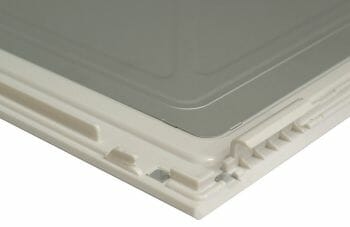
Winding up the description of the exterior I want to note one of the distinguishing features of the Performance One series: these system cases have 3-layer panels with a layer of plastic in between two layers of aluminum. This design helps the case to be quieter than its opponents: the sandwich effectively minimizes high-frequency noise and vibration as you can make sure of by tapping on the panel with your finger. You will hear a dull sound, without a metallic clang.
Now we have reached the internals. The case is indeed full of the family traits such as the overall high quality of manufacture, handy cages for HDDs, and the partitioning of the interior space into two nearly isolated compartments. The top compartment is for the mainboard and everything related to it as well as for most of drives, including all hard disk drives. The bottom compartment accommodates a power supply and two open 5-inch bays. This partitioning ensures simpler airflows with less turbulence.
The case can even be viewed as having three partitions because there is space for cables between the mainboard’s mounting plate and the right panel. Practice suggests that this design facilitates the final step of assembly when you have to tuck the various cables and wires in somewhere. The cooling of the components in the main compartment is improved because the airflows meet less resistance from cables and thus retain high speed. The only downside is that this solution sets forth an additional requirement to the power supply which must have long enough cables for the longer routes towards the connectors.
Various user-centric improvements can be found inside: there are handy hooks for cables straps, there are straps themselves (the photo shows those of them that are already fastened on the system case; a few more cable straps are included into the box), and there is a handy box for various small things at the back of a HDD cage.
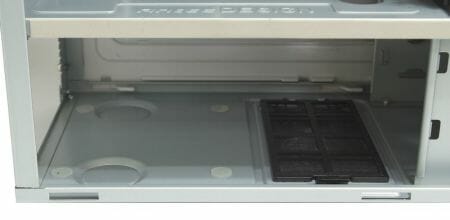
The bottom compartment is exceedingly simple. The power supply lies on four damping pads and is fastened with screws to the back panel. Of course, if you’ve got a PSU with a horizontal fan, you should install it upside down, with the fan facing up, so that the fan could get the air it needs. The vent hole in the bottom of the case allows fresh air to get into this compartment.
I guess the manufacturer’s attention to small details is a very satisfying thing. Here, you can see an easily detachable dust-filtering mesh. It is appropriate because dust is going to accumulate under the system case.
The top and bottom compartments connect through a small slit which can be almost completely closed with a special moving plate.
The back panel is quite an ordinary thing on the inside.
There is a seat for a 120mm fan in front of each of the two HDD cages. Thus, you can ensure more comfortable conditions for your HDDs inside this system case than in Antec’s gaming series cases. The cages can be easily extracted thanks to the plastic rails.
The cages differ because the developer wanted to make the case smaller.
The top cage can accommodate three HDDs positioned vertically. They are fastened to the cage with large-headed screws via soft damping pads.
The bottom cage can only take in two HDDs and you have to use special guides for them. The guide is fastened to the bottom of the HDD using the same screws and pads as in the top cage.
Take note of the rings attached to the sides of the cages. You can pull at them to easily take a cage out of the case. You should not worry that the rings might rattle: the HDDs are damped properly in the cages whereas the rings are fixed in special plastic clips.
You may have noticed that there are rather large square depressions in the front panel on both sides of the 5-inch bays. Besides making it easy to remove the faceplates, they help in installing 5-inch devices. The front parts of the guides the devices run into the bays on fit into these depressions. Thus, the designers have solved the common problem of making the installation process quick and simple without having to remove the front panel.
A 3.5-inch device can be installed into an open 5-inch bay using a guide and a faceplate.
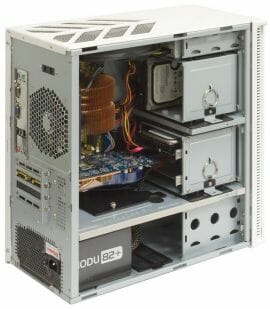
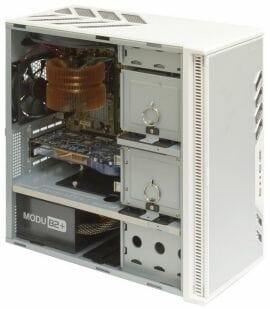
I met no problems when I was assembling a computer in this system case. As usual, the additional space for cables between the panels helped move most wires and cables away from the mainboard and simplified the final step of the assembly process.
Frankly speaking, I wanted to replace the mainboard I used because it only had two SATA connectors whereas the system case could easily accommodate four HDDs. I did not change anything, though. After all, few users of this system case are going to have more than two HDDs.
By the way, the power connector of the long graphics card I use in my tests was very close to the bottom HDD cage. If two HDDs were installed into it, the connector got in the way of the bottom HDD. And my card is not the longest available: the Nvidia GTX 260 is 4 centimeter longer, for example. This is just a small nuisance, though. Even if you are going to use a very long professional graphics card, you will be able to fit it in by removing the bottom HDD cage altogether and installing your HDDs into the top cage. Or you can just not install the HDD opposite the graphics card – the cage design with longitudinal positioning of HDDs is especially good then.
Besides, if you are going to install your optical drive into the top 5-inch bay, you should select a model with a length of 170 millimeters or less. Otherwise it will hit against the 200mm fan. The bottom bays are free from this limitation. And generally speaking, most of today’s optical drives meet that requirement, too.
Antec NSK6580B
As opposed to the original Mini P180, the Antec NSK6580B is a variation of the ordinary midi-Tower concept.
Like the model discussed in the previous section, the NSK6580B comes in two colors: all black or with a silvery front panel. It is hard to choose the better of the two: both variants are rather boring visually, being typical unembellished square boxes. I don’t mean that the case is ugly. It just does not provoke a strong emotion. Take note of the protruding front panel: the gap allows for the intake of air.
The side panel is reminiscent of HEC (Ascot) products.
The column of buttons and connectors includes a small Reset button (most people will need a pen or something to press it), a metallized Power button, two audio connectors, two USB ports, and a FireWire port. You can easily plug two USB devices in without any problems.
The back panel is absolutely standard. The only noteworthy thing here is the 120mm fan. Antec stands its ground: no plastic and no stiff rubber for the feet of the system case.
There are two vent grids in the side panel of the case opposite the CPU and expansion cards. A plastic funnel is installed on the interior of the top grid. It serves to deliver fresh air to the CPU cooler’s fan. This solution only works well with boxed or similar coolers, though. If you’ve got a large CPU cooler, you may want to remove the funnel or replace it with an 80mm fan.
The interior design makes me use the word standard again. The only unusual element is the large detachable cage for hard disk drives. This standard system case is high quality, though. The edges are all finished neatly, and every detail is rigid enough for you not to worry about rattle.
Some elements of this design resemble HEC/Ascot products. I suspect this company is the real manufacturer of the NSK6580B whereas Antec just added a few design elements.
Take note that the fan is from the TriCool series again. That is, it features a 3-step speed control. The removable brackets and the base plate with screws at the back panel look familiar.
The drives rack is an ordinary thing with 5-inch bays at the top and a HDD cage at the bottom. 5-inch devices are fastened in the old way, with screws.
There are fan seats behind the cage. It is somewhat unusual that two 92mm rather than one 120mm model are supposed to be used. But this solution is logical considering how tall the drives rack is.
The cage resembles those used in other Ascot cases but differs with its size. It can accommodate not four but five HDDs, each drive on its own guide (in the original HEC/Ascot cases, save for the latest models, they are fastened with screws).
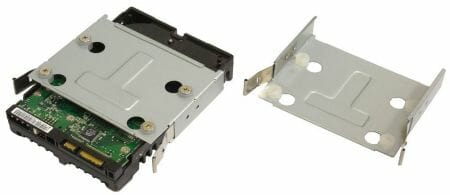
The rails are exactly the same as in other Antec cases: the HDD is fastened to the guide via damping silicone pads with four screws.
A special guide is necessary to install an external 3.5-inch device. The guide is simple but universal and won’t have problems with card-readers that lack some of the standard mounting holes.
It is easy to assemble a computer in this system case although laying the cables neatly is a bother after the Mini P180. Take note that the graphics card connector conflicts with one HDD again: the length of modern graphics cards may become a problem.
Test Methods
The assembled system case is tested at a constant ambient temperature of 23°C maintained by an air conditioner. As we assume that most users prefer low-noise system cases, we set the speed of the CPU and system fans (those connected to the mainboard) into Silent mode (the quietest mode on ASUS mainboards). If the system case has its own speed controller, the fans connected to it are set at the lowest speed, too, whenever possible. We do not change the default configuration of airflows determined by the system case design.
The following components are installed into the system case:
- ASUS P5E mainboard
- Core 2 Duo E6850 processor
- Zalman CNPS9500 AT cooler
- Four hard disk drives Western Digital Raptor WD740GD
- HIS IceQ3 Radeon HD 3870 graphics card
- 2GB DDR2-800 SDRAM Patriot PDC24G6400LLK
- Microsoft Windows XP Professional SP2
The Antec Mini P180 is designed for microATX mainboards, so I used an ASUS P5G-MX mainboard for it. This mainboard does not support a FSB frequency of 1333MHz, so the E6850 processor worked not at its default 3GHz but at 266×9=2400MHz on it. Anyway, even at the reduced frequency its heat dissipation is comparable to that of modern dual-core Core 2 Duo E8xxx and E7xxx series processors manufactured on 45nm tech process.
The Antec Mini P180 comes without a power supply so I installed an Enermax MODU82+ EMD625AWT, a 625W power supply, into it. The Antec NSK6580B was tested together with its default Antec EarthWatts EA430D (430W) power supply.
The CPU temperature is read with ASUS PC Probe included with the mainboard. The temperature of the HDDs is measured with HDD Thermometer. The graphics card’s temperature is reported by its control panel.
There are the following test modes:
- Idle
- IOMeter (IOMeter’s Access Time test running on all the HDDs to load them fully)
- Prime95 (Prime95 running in In-Place Large FFTs mode to load both CPU cores fully)
- 3DMark06 (3DMark06 running at 1280×1024 with maximum graphics quality settings)
Every temperature is read after the system has worked for half an hour in the current test mode. The noise level is evaluated subjectively. The following table lists the brief specs of the tested system cases.
Test Results
I will first discuss the performance of each system case individually.
The first HDD is installed into the middle of the top cage; the second HDD is in the top guide of the bottom cage.
Even when the fan speed is at the minimum, the Antec Mini P180 copes well with cooling all of the components, including HDDs. Take note of the low temperature of the CPU. This is due to the reduced clock rate, but the system case will surely cope with hotter and faster CPUs. The clever configuration of airflows shows its benefits here: the two fans in the corner of the chassis are successfully pumping a strong stream of air through the entire case.
The system case should also be praised for its quietness. It is almost silent at the minimum speed of the fans. You can only hear a soft rumble of the HDDs’ heads. And even the HDDs are far quieter here than in standard system cases due to the 3-layer panels. The large fan is good, too. It is silent at low speed – you can hear a soft hiss of the airflow only if you put your ear right next to the fan!
However, when you switch to medium speed, the case becomes audible: the fans are not quiet anymore. And finally, the noise is downright irritating at max speed and is mostly produced by the 200mm fan.
I also tested this system case at the max speed of the fans.
The effect is obvious: every component is cooler now in every mode. The graphics card and HDDs benefit the most from the stronger airflow when under load. I don’t think the increased noise is worth the improvement in temperature, though. Every component is quite comfortable even at minimum speed, so why should you lose your own acoustic comfort? If you do want to improve cooling efficiency, you can try to install a couple of slow and quiet fans on the front panel.
That was not the end of my test, though. If this system case is so good at cooling, perhaps it can handle the CPU in passive mode? I did not look for a special cooler for that. I just unplugged the fan cable of the already installed Zalman CNPS9500 AT. The system fans worked at minimum speed again.
The Antec Mini P180 passes this test! Of course, the CPU temperature is high under load, yet remains within acceptable limits. Thus, you can us passive coolers even for rather fast CPUs in this system case to reduce the overall noise of your computer even more.
The HDDs are numbered from top to bottom.
The Antec NSK6580B is very good and cools every component well. I should note, however, that the HDDs are rather hot, even though not as alarmingly hot as 50°C or higher. This might have been expected because system cases with only one exhaust fan are usually not very good at cooling HDDs (and the HDDs used in this test are very hot themselves). The NSK6580B seems to have proper ventilation in the front part of the case. The fact that the HDDs are installed with gaps rather than next to each other must have helped, too. The second HDD from top is a good example of that point: being the only HDD that is squeezed between two other HDDs, it has a considerably higher temperature than the others in every mode.
It is all right about the noise factor, of course. The high quality of manufacture guarantees the lack of undesired noises whereas the single 120mm fan cannot be loud at minimum speed. Thus, it is the HDDs that were the main source of noise in the system. Frankly speaking, the difference from the Mini P180 was easily perceptible. The buzzing of the rotating platters and the clatter of the heads during the IOMeter: Access Time test was much clearer and louder.
Now let’s compare the system cases with each other. So, the Mini P180 is obviously better when idle. The 200mm fan on the top panel greatly improves the cooling of the system components.
The 200mm fan also contributes to the cooling of HDDs. But again, the NSK6580B is very good for a system case in which there is only one exhaust 120mm fan and four 10,000rpm HDDs working at their full speed.
It is not quite correct to compare these results because the CPU worked at a reduced frequency in the Mini P180. However, you can note that you don’t get much by switching the fans to their max speed. The benefits are small and inconspicuous for ordinary usage (you can achieve the same effect by using a more efficient type of thermal grease). The option of passive cooling of the CPU is appealing, too. The temperatures are far from dangerous even then.
Finally, here is the gaming load. The graphics card is cooled much better in the Mini P180 when you switch the system fan to max speed. However, noise is an issue. I would instead prefer to install an additional fan on the front panel opposite the graphics card. The CPU with passive cooling feels all right under gaming load.
Conclusion
Summing this test session up, I must acknowledge the high quality of the Antec brand. Every system case from Antec, from the miniature NSK1380 to the huge Twelve Hundred and from the handy and quiet P182 to the unsophisticated NSK6580B, shares the same high quality of manufacture, attention to small details and lack of serious defects in design. Of course, they come at a higher price than most opponent products, but you are guaranteed high quality for your money.
Talking about the specific products discussed in this review, the Antec Mini P180 has made more vivid impression, of course. The company has indeed managed to reduce the size of Performance One system cases while keeping all of their advantages. The resulting product has a standard size, good cooling, excellent sound insulation, and handy design. There is only one thing that can repel some users from it: it is meant for microATX mainboards only. If you don’t have anything against such mainboards, you may find this system case to be the rare example of a lucky compromise of features.
The Antec NSK6580B is simpler both externally and internally. In fact, it is comparable to many midrange system cases that are meant just to work properly rather than to impress the user in some way or another. And this product does its job well. Even with one 120mm fan it effectively cooled all system components in my tests, including four HDDs.